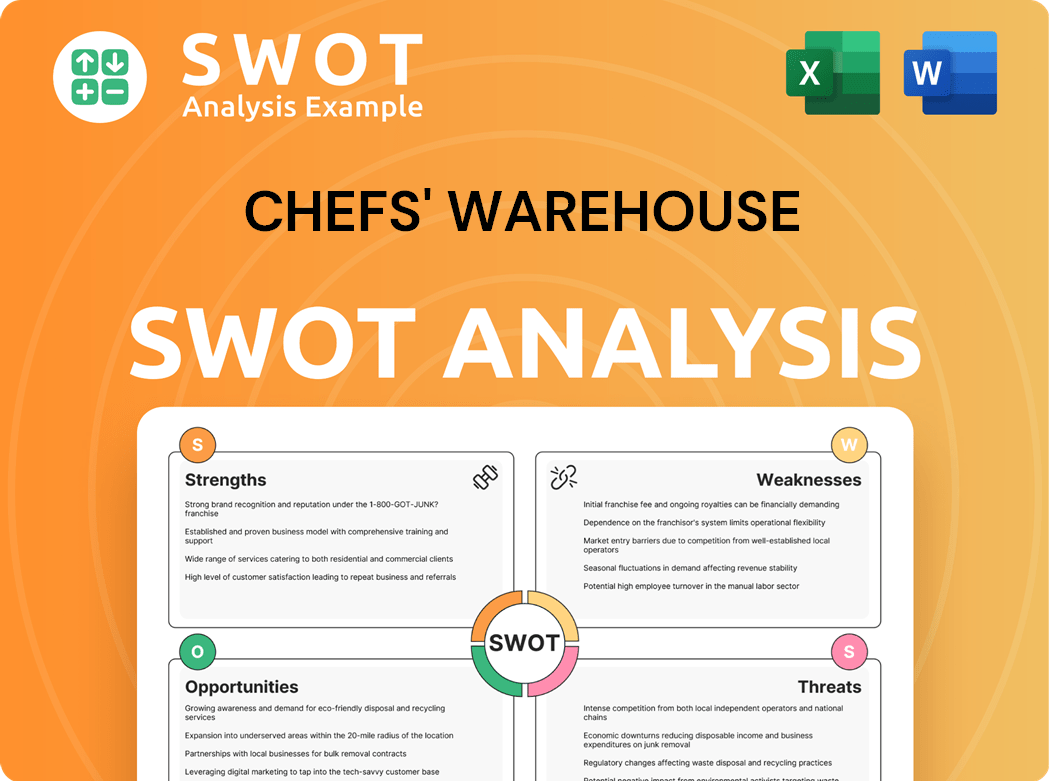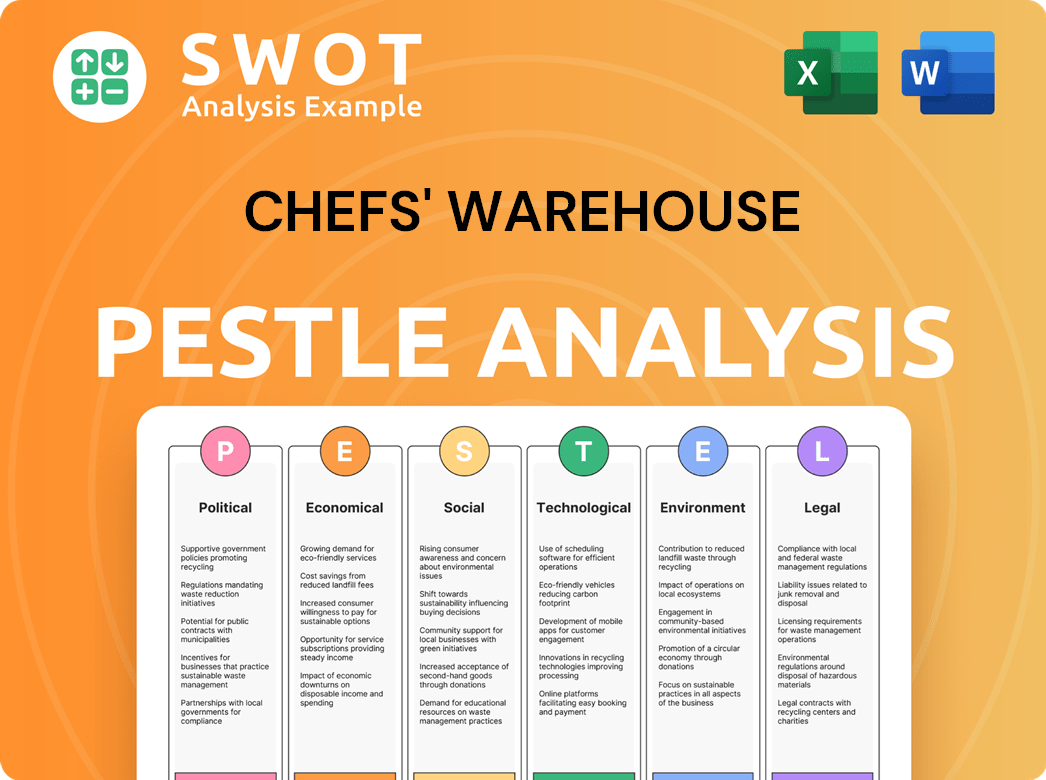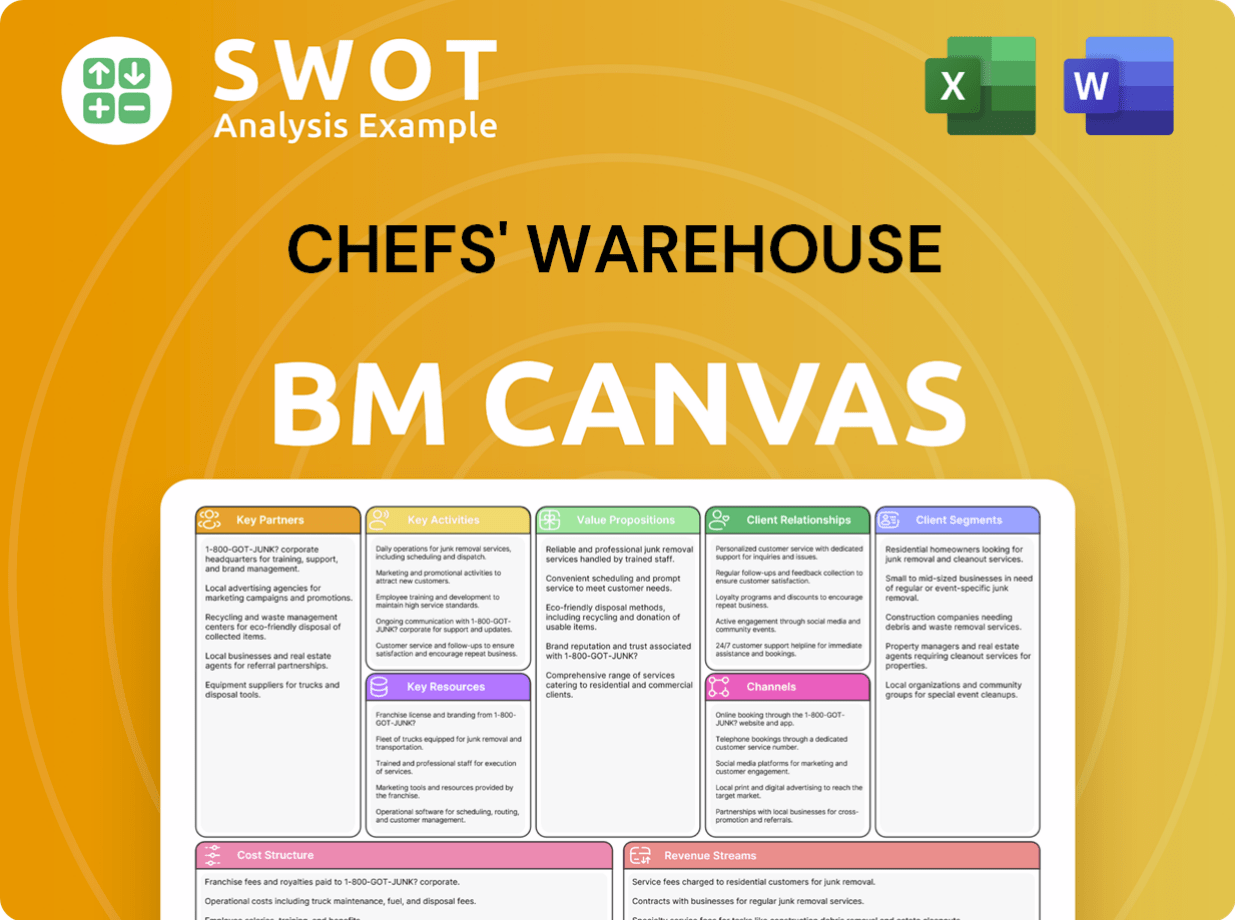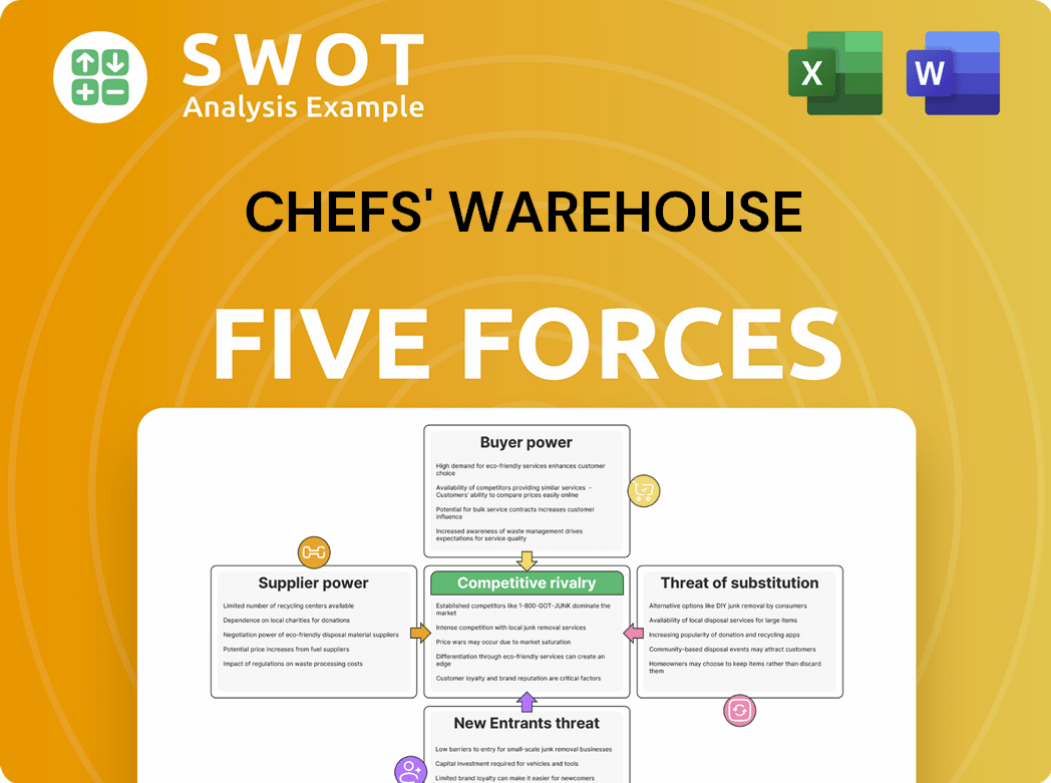Chefs' Warehouse Bundle
How Does Chefs' Warehouse Dominate the Food Distribution Game?
In the high-stakes world of culinary excellence, the quality of ingredients can make or break a dining experience. The Chefs' Warehouse, a leading specialty food distributor, has built its empire on providing top-tier chefs with access to unique and often hard-to-find products. But how does this company, born in the heart of New York City, maintain its competitive edge in a fiercely contested market? This analysis dives deep into the Chefs' Warehouse SWOT Analysis, exploring its rivals, strengths, and strategies.

Understanding the Chefs' Warehouse competitive landscape is crucial for anyone involved in the foodservice industry. This includes a thorough market analysis of its key competitors and an examination of its financial performance. This exploration will also investigate its distribution network, regional presence, and the company's growth strategy, providing valuable insights into its long-term prospects. A detailed competitor analysis will reveal the challenges and opportunities within the food distribution sector.
Where Does Chefs' Warehouse’ Stand in the Current Market?
The Chefs' Warehouse holds a strong market position within the specialty food distribution sector, primarily serving the upscale culinary market. The company is a leader in supplying high-quality ingredients to fine-dining establishments across the United States and Canada. Its core operations revolve around providing a comprehensive range of specialty foods, including unique cheeses, charcuterie, oils, vinegars, and spices, along with pastry, bakery items, and high-quality proteins.
This comprehensive product portfolio allows it to be a one-stop shop for many high-end culinary operations, solidifying its reputation as a provider of superior products. The company's value proposition centers on offering premium products and reliable service to a discerning customer base. This focus allows The Chefs' Warehouse to differentiate itself from broader, more commoditized food service distributors.
Geographically, The Chefs' Warehouse has expanded its presence significantly, operating numerous distribution centers across North America. This extensive distribution network enables efficient delivery to its diverse customer base. The company's strategic acquisitions, such as Allen Brothers in 2019 and Hardie's Fresh Foods in 2024, have further bolstered its product offerings and regional presence, strengthening its competitive advantages within the food distribution industry.
While precise market share figures for the specialty food distribution niche are difficult to obtain, The Chefs' Warehouse is recognized as a significant player. The company's focus on premium products and its extensive distribution network support its strong market position. The company's financial performance, with net sales of $5.20 billion for the fiscal year ended December 29, 2023, reflects its substantial scale within the industry.
The customer base primarily consists of fine-dining restaurants, hotels, and other high-end culinary operations. The company's focus on quality and service attracts chefs and establishments seeking premium ingredients. The Chefs' Warehouse has cultivated strong relationships with its customers, providing a reliable source of high-quality products. The company's customer base is a key factor in its competitive advantages.
Key competitive advantages include its focus on premium products, extensive distribution network, and strong supplier relationships. The acquisition of Allen Brothers in 2019 and Hardie's Fresh Foods in 2024 have expanded its product offerings and regional presence. The company's ability to provide specialized products and services differentiates it from larger, more generalized food distributors. Revenue Streams & Business Model of Chefs' Warehouse provides further insights into its operational strengths.
Challenges include competition from both national and regional distributors, as well as the need to manage costs and maintain margins in a competitive market. Opportunities exist for expansion into new geographic markets and further diversification of product offerings. The company can leverage its strong brand reputation to explore new growth avenues. Its ability to adapt to industry trends will be crucial.
The Chefs' Warehouse reported net sales of $5.20 billion for the fiscal year ended December 29, 2023. This financial performance underscores its robust health compared to many smaller, regional players, demonstrating its capacity for continued investment in infrastructure and product expansion. The company's strategic acquisitions and focus on premium products have contributed to its financial success.
- The company's financial performance indicates its ability to maintain a strong position in the market.
- The company's ability to expand its product offerings and customer base is a key factor in its financial success.
- The company's financial performance is a key indicator of its competitive advantages.
- The company's financial performance is a key indicator of its growth strategy.
Chefs' Warehouse SWOT Analysis
- Complete SWOT Breakdown
- Fully Customizable
- Editable in Excel & Word
- Professional Formatting
- Investor-Ready Format

Who Are the Main Competitors Challenging Chefs' Warehouse?
The competitive landscape for The Chefs' Warehouse is complex, involving both direct and indirect rivals in the food distribution sector. Understanding these competitors is crucial for a thorough market analysis and evaluating the company's position. This analysis helps in assessing Chefs' Warehouse's strengths and weaknesses.
Direct competitors focus on providing high-quality ingredients to fine dining establishments. Indirect competitors include larger broadline distributors that have a wider market reach. The foodservice industry is dynamic, with constant changes in the competitive environment.
The Chefs' Warehouse faces competition from various sources, including specialty food distributors and broadline distributors. These competitors influence the company's market position and strategic decisions. A detailed competitor analysis is essential for understanding the challenges and opportunities in the market.
Direct competitors include specialty food distributors that focus on high-quality ingredients for fine dining. These companies compete by offering curated product selections and personalized service. They often have strong local relationships with chefs.
Baldor Specialty Foods is a key direct competitor, known for its extensive range of produce and specialty items. Regional gourmet food distributors with strong local networks also pose a challenge. These competitors focus on providing unique, high-quality products.
Indirect competition comes from larger, more diversified food service distributors. These companies serve a broader market, including casual dining and institutional food service. They have significant purchasing power and logistical advantages.
Sysco Corporation and US Foods are major indirect competitors. They have specialty divisions or premium product lines that overlap with The Chefs' Warehouse's offerings. These companies have extensive distribution networks.
New players and business models are emerging in the market. Direct-from-farm suppliers and technology-driven platforms are connecting chefs directly with producers. These models bypass traditional distributors and offer alternative supply chains.
Mergers and acquisitions within the industry reshape competitive dynamics. Sysco's past acquisitions of specialty distributors have intensified competition. These changes require The Chefs' Warehouse to maintain its distinct value proposition.
The Chefs' Warehouse's success depends on several factors. These include the quality and uniqueness of its products, customer service, and distribution network. Maintaining a competitive edge requires a focus on these key areas.
- Product Quality and Selection: Offering a wide range of high-quality, specialty products.
- Customer Service: Providing personalized service and building strong relationships with chefs.
- Distribution Network: Ensuring efficient and reliable delivery of products.
- Pricing Strategy: Balancing competitive pricing with the value of premium products.
- Innovation: Adapting to new market trends and customer needs.
Chefs' Warehouse PESTLE Analysis
- Covers All 6 PESTLE Categories
- No Research Needed – Save Hours of Work
- Built by Experts, Trusted by Consultants
- Instant Download, Ready to Use
- 100% Editable, Fully Customizable

What Gives Chefs' Warehouse a Competitive Edge Over Its Rivals?
The Chefs' Warehouse has carved a distinct niche in the competitive landscape of food distribution, particularly within the high-end culinary sector. The company's success stems from a focused strategy that prioritizes quality, exclusivity, and specialized service. This approach has allowed it to build a strong brand reputation and customer loyalty, setting it apart from broader foodservice distributors.
The company's competitive edge is rooted in its understanding of the needs of chefs and culinary professionals. This understanding has guided its product selection, distribution network, and sales strategy. By focusing on premium ingredients and providing expert culinary knowledge, The Chefs' Warehouse has created a comprehensive ecosystem that supports the high-end culinary community. For more insights into their target audience, consider exploring the Target Market of Chefs' Warehouse.
The company's ability to source rare and premium ingredients globally is a key differentiator. This, combined with its specialized distribution network and culinary expertise, positions it uniquely in the foodservice industry. The Chefs' Warehouse's commitment to quality and service has allowed it to maintain a competitive advantage in a market where discerning chefs demand the best.
The Chefs' Warehouse offers a highly curated selection of specialty foods, unique proteins, and artisanal ingredients. This focus on premium products is a key differentiator. The company's product offerings often include items not available through broader distributors, catering to the specific needs of high-end chefs.
Unlike general food service distributors, The Chefs' Warehouse operates a specialized supply chain designed for delicate, perishable, and high-value products. This includes temperature-controlled facilities and specialized delivery fleets. This ensures the integrity of products from source to kitchen.
The company's sales force comprises individuals with deep culinary knowledge, acting as consultants to chefs. They offer product recommendations and insights, enhancing customer relationships. This expertise further solidifies its position in the competitive landscape.
The focus on quality and exclusivity has fostered strong brand equity and significant customer loyalty. Discerning chefs rely on these specific products to execute their culinary visions. This loyalty is a key competitive advantage in the foodservice industry.
The Chefs' Warehouse's competitive advantages are multi-faceted, including a curated product portfolio, a specialized distribution network, and culinary expertise. These advantages contribute to its strong market position. The company's focus on premium products and customer service differentiates it from competitors.
- Product Differentiation: Offers unique and hard-to-find ingredients.
- Specialized Distribution: Handles delicate and high-value products efficiently.
- Culinary Expertise: Provides expert advice and support to chefs.
- Customer Loyalty: Maintains strong relationships with discerning chefs.
Chefs' Warehouse Business Model Canvas
- Complete 9-Block Business Model Canvas
- Effortlessly Communicate Your Business Strategy
- Investor-Ready BMC Format
- 100% Editable and Customizable
- Clear and Structured Layout

What Industry Trends Are Reshaping Chefs' Warehouse’s Competitive Landscape?
The food distribution sector, especially the specialty segment, is undergoing significant transformations. These changes present both challenges and opportunities for The Chefs' Warehouse. Technological advancements, evolving consumer preferences, and regulatory shifts are key factors influencing the competitive landscape and future outlook for the company.
The company faces risks from economic volatility, supply chain disruptions, and the need to adapt to changing culinary trends. However, it is also well-positioned to capitalize on premiumization in dining, emerging markets, and strategic partnerships. The Chefs' Warehouse must navigate these dynamics to sustain its market position and drive growth.
The foodservice industry is seeing increased e-commerce, AI-driven inventory management, and last-mile delivery. Consumers are demanding locally sourced, sustainable, and plant-based ingredients. Regulatory changes related to food safety and supply chain transparency are also impacting operations.
Maintaining pace with rapid technological shifts and integrating them into a high-touch service model is a challenge. Adapting to evolving consumer preferences requires constant innovation. Global economic shifts, including inflation and supply chain disruptions, pose ongoing threats.
Premiumization of dining experiences and expansion into emerging culinary markets offer growth potential. Strategic partnerships, investment in sustainable sourcing, and leveraging data analytics can strengthen its competitive position. Acquisitions, like the March 2024 purchase of Hardie's Fresh Foods, demonstrate a proactive approach.
Focus on the high-value customer segment is crucial. Adaptation to technological advancements and diversification of product offerings are essential. Strategic supply chain management is vital to navigate macroeconomic volatility. Review Owners & Shareholders of Chefs' Warehouse for more insights.
The Chefs' Warehouse reported a net loss of $13.5 million in Q1 2024, reflecting economic challenges. The acquisition of Hardie's Fresh Foods expanded its footprint and product offerings. The company's ability to adapt and innovate will determine its long-term success in the foodservice industry.
- Focus on premium products and services.
- Embrace technological advancements in distribution.
- Diversify product offerings to meet evolving consumer demands.
- Strategically manage supply chain and costs.
Chefs' Warehouse Porter's Five Forces Analysis
- Covers All 5 Competitive Forces in Detail
- Structured for Consultants, Students, and Founders
- 100% Editable in Microsoft Word & Excel
- Instant Digital Download – Use Immediately
- Compatible with Mac & PC – Fully Unlocked

Related Blogs
- What are Mission Vision & Core Values of Chefs' Warehouse Company?
- What is Growth Strategy and Future Prospects of Chefs' Warehouse Company?
- How Does Chefs' Warehouse Company Work?
- What is Sales and Marketing Strategy of Chefs' Warehouse Company?
- What is Brief History of Chefs' Warehouse Company?
- Who Owns Chefs' Warehouse Company?
- What is Customer Demographics and Target Market of Chefs' Warehouse Company?
Disclaimer
All information, articles, and product details provided on this website are for general informational and educational purposes only. We do not claim any ownership over, nor do we intend to infringe upon, any trademarks, copyrights, logos, brand names, or other intellectual property mentioned or depicted on this site. Such intellectual property remains the property of its respective owners, and any references here are made solely for identification or informational purposes, without implying any affiliation, endorsement, or partnership.
We make no representations or warranties, express or implied, regarding the accuracy, completeness, or suitability of any content or products presented. Nothing on this website should be construed as legal, tax, investment, financial, medical, or other professional advice. In addition, no part of this site—including articles or product references—constitutes a solicitation, recommendation, endorsement, advertisement, or offer to buy or sell any securities, franchises, or other financial instruments, particularly in jurisdictions where such activity would be unlawful.
All content is of a general nature and may not address the specific circumstances of any individual or entity. It is not a substitute for professional advice or services. Any actions you take based on the information provided here are strictly at your own risk. You accept full responsibility for any decisions or outcomes arising from your use of this website and agree to release us from any liability in connection with your use of, or reliance upon, the content or products found herein.